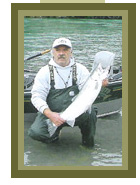 |
At certain times of the year, the steelhead are joined by the annual salmon run. They are found in the lower Klamath, the Smith, and the Chetco Rivers. All are familiar to your guide, who will put you in the right spot for tackle-busting excitement!
The Klamath River
Fall Salmon -- August 15 to October 15
The Klamath river, known as the salmon capitol of the world, is renowned for its fishing for king salmon and summer steelhead (called half-pounder). The Klamath is probably one the most productive salmon fishing sites in the world -- during the main run our guides will hook and release over 20 salmon per day on light tackle. The king salmon are usually smaller than in most rivers averaging from 8 to 20 lbs. with a few up to 40 lbs. but the abundance of fish and light tackle makes for a day that will always be remembered. The mild temperatures, beautiful scenery, comfortable jet boats, and abundance of fish and wildlife make the Klamath the best of all fishing trips for families, groups, business and corporate groups as well as plenty of fun.
Spring Salmon -- April to July 15
The spring salmon is also a Chinook or king salmon that enters the system from April through July 15. They can be a little more difficult to catch because generally they are always moving or migrating up river. The wait is worth while as Springer is the best fighting pound-for-pound of the king salmon and by far the best eating.
|
 |
 |
|
Summer Steelhead
The Klamath River is well known for its summer steelhead, better known as half pounders, ranging from 1/2 lb. to 5 lbs. The summer steelheads are very aggressive and put on a terrific aerobatic display when hooked. Fly fishermen from all over the world will visit the Klamath just for the half-pounder runs. They are also easily caught on spinners, puff balls, glow-bugs, and bait.
|
|
The Smith River
The Smith River, California's most northern coastal river located 5 miles south of the Oregon border, is known for its breathtaking beauty, large boulders, and emerald-clear swift water. The Smith River, surrounded by the largest trees in the world, Six Rivers Natural Forest, and Jedediah Smith State Park, is a must see for anyone visiting the North Coast. The Smith River is well known for producing the state record steelhead, 27lb. 4 oz., and many other steelhead over 20 pounds. While the average chinook (king) salmon weighs between 20-40 pounds, the Smith River also holds the record for the second largest Chinook caught at 86 pounds. After the large winter storms that frequent the North Coast on a regular basis, Smith River is always the first river to clear, sometimes over night. Some of the other rivers and streams can take 1-2 weeks depending on their drainage system.
The Smith is the longest of the free flowing rivers in the state and has carved itself down to bedrock leaving very little siltation to cloud its waters. After the flood of 1964, the Smith River, like most North Coast Rivers, was devastated. The high water eradicated most of the spawning fish and decimated the spawning grounds. For years after there was a noticeable decline in the runs of fish. In 1970 the State of California issued a special permit to build the first privately owned fish hatchery in the state, the Rowdy Creek Fish Hatchery. They have been a major factor for the great fishing we have today. Fishing the Smith River, like all other rivers on the North Coast, is dependent on both weather conditions and water conditions. Some days are very successful and some days are not. If anyone ever tells you they catch fish everyday they fish on the Smith, they probably don't fish often. To say that fish are caught everyday would not be truthful. However, due to our experience and knowledge of the rivers, through the years we have maintained one of the highest catch ratios on the North Coast.
|
|
|
The Chetco River
The Chetco River is located 5 miles north of the Oregon Border on Highway 101 in the town of Brookings. The Chetco is a smaller, coastal river with approximately 15 miles of fishing access. Don't let its' size fool you. This is the favorite river of many of our guides. Trophy steelhead into the 20 pound category have been caught during winter fishing and Chinook (king) salmon over 60 pounds have been landed here. The Chetco is a very well managed fishery and consistently has some of the most productive steelhead fishing on the North Coast. Like all free flowing rivers on the Coast, weather and water conditions can create quick changes in itís' fishability. Free flowing rivers usually drop and clear quickly after winter storms and the Chetco is no exception. Usually 2-3 days after normal storms, the river is in perfect shape but it is always good to check the River Flow Charts.
The Russian River
The Russian River is located approximately 60 miles north of San Francisco. It runs from the Coyote Dam near Ukiah to Jenner-by-the-Sea on the California coast where it empties into the Pacific Ocean. Fishing on the Russian is for winter steelhead.
Return to the top
|
|




